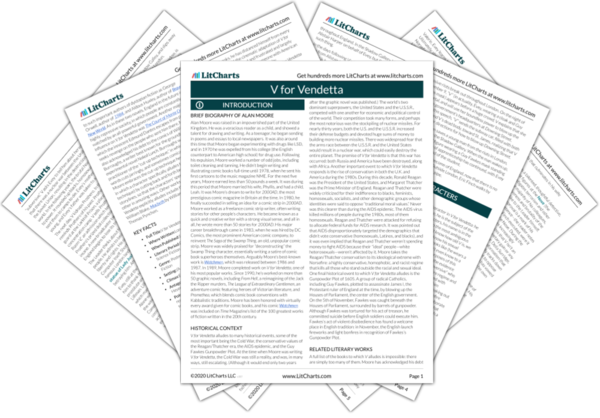From the first chapter of V for Vendetta, Alan Moore shows us the enormous power that symbols have over a society. V, the protagonist of the graphic novel, wears a Guy Fawkes mask, and draws “V” symbols almost wherever he goes. After saving Evey Hammond from a group of murderers, V takes her to watch as he blows up the Houses of Parliament, a centuries-old symbol of the strength and power of the English government. In a sense, V for Vendetta is about a fight between two sets of symbols: the austere, Fascist symbols of the Norsefire government, and the anarchic, more anonymous symbols of V. It’s worth understanding what the stakes of this conflict are.
To begin with, Moore makes it clear that symbols are highly powerful weapons—indeed, the Norsefire government rules England by cleverly manipulating symbols. One important symbol in the Norsefire regime is the Voice of Fate. Every evening, Lewis Prothero reads news determined by the Fate Computer. His voice is so impressive, and its presence so pervasive, that people think the voice is literally that of the Fate Computer. The Voice of Fate comes to symbolize the strength and omnipresence of the Norsefire government.
One reason that symbols like the Voice of Fate are so powerful is that they’re superhuman. As V explains, a single human being can express his views however he likes, but he’ll always be limited by his humanity: the everyday-ness of his face, the inevitability of his death, etc. A symbol, in contrast, isn’t directly tied to one human being. In the case of the Voice of Fate, for instance, the Norsefire government actively tries to ensure that people don’t realize that the voice is, in fact, tied to one human being. The less “human” a symbol is, the more mysterious and powerful it becomes.
In order to undermine the Norsefire government, V attacks its symbols—either replacing them with his own, or using them against their creators. After blowing up Parliament, V kidnaps Prothero and drives him insane, leaving the Voice of Fate frail, tremulous, and conspicuously human. People begin to realize that the Voice of Fate—and thus the Norsefire government—is only human, and thus flawed. V’s own symbols become increasingly popular: we see children and others copying his “V” symbol in graffiti-form. The beauty of the “V” symbol, like the power of V’s Guy Fawkes mask, lies in its anonymity. Anyone can carve a “V” onto a wall, meaning that every citizen of England is a potential threat to the authority of the Norsefire government. V uses symbols—simple, reproducible, and anonymous—to build up his cause’s power and influence and, implicitly, to undermine the power and influence of the government.
At the end of V for Vendetta, we’re given a particularly clear illustration of the superhuman power of symbols. Eric Finch shoots V, killing him, but before he dies, V whispers, “You can’t kill an idea. Ideas are bulletproof.” The same might as well be said for symbols: although V dies, he passes on his home, his education, and, crucially, his set of symbols—the mask, the cloak, the “V”—to his loyal student, Evey Hammond. Evey, now wearing V’s old mask, introduces herself to London as V. By himself, V—and, for that matter, Evey—is only human. Yet V’s symbols are indestructible: passed from one person to the next, they take on a life of their own. In all, V for Vendetta has been a battle between two sets of symbols: Norsefire’s and V’s. In the end, the more anonymous, reproducible set of symbols wins.
The Power of Symbols ThemeTracker

The Power of Symbols Quotes in V for Vendetta
Remember, remember the fifth of November, the Gunpowder treason and plot. I know of no reason why the Gunpowder treason should ever be forgot.
They eradicated some cultures more thoroughly than they did others. No Tamla and no Trojan. No Billie Holliday or Black Uhuru. Just his master’s voice every hour on the hour.
Her name is anarchy! And she has taught me more as a mistress than you ever did! She has taught me that justice is meaningless without freedom. She is honest. She makes no promises and breaks none.
You see, there are two possible motives here. Not one. The first motive is revenge. He escapes from Larkhill and vows to get even with his tormentors. The Parliament bombing and the other stuff is just a smokescreen. The whole exercise was an elaborate, chilling vendetta. That’s the explanation that I find the most reassuring, funnily enough. Because that means he’s finished now. That means it’s over. The second motive is more sinister. Like I said, everyone who could have identified him is now dead. What if he’s just been clearing ground? What if he’s been planning something else?
Uncaring fate? It is said there is no question that can be formulated that you cannot answer. Tell me this, then: Am I loved?
Because if I’m going to crack this case, and I am, I’m going to have to get right inside his head, to think the way he thinks, and that scares me.
“Did you think to kill me? There’s no flesh or blood within this cloak to kill. There’s only an idea. Ideas are bulletproof.”
Because you were so big, V, and what if you’re just nobody? Or even if you’re someone, you’ll be smaller, because of all the people that you could have been, but weren’t.











